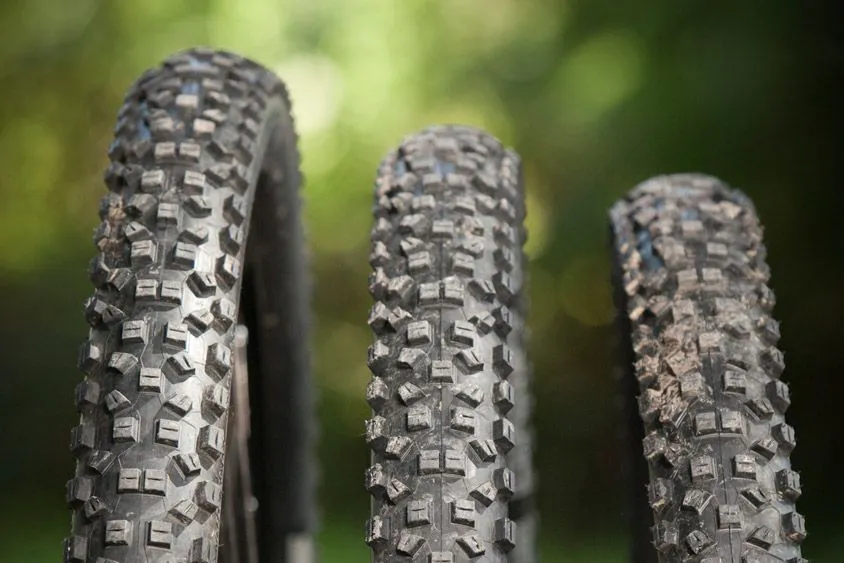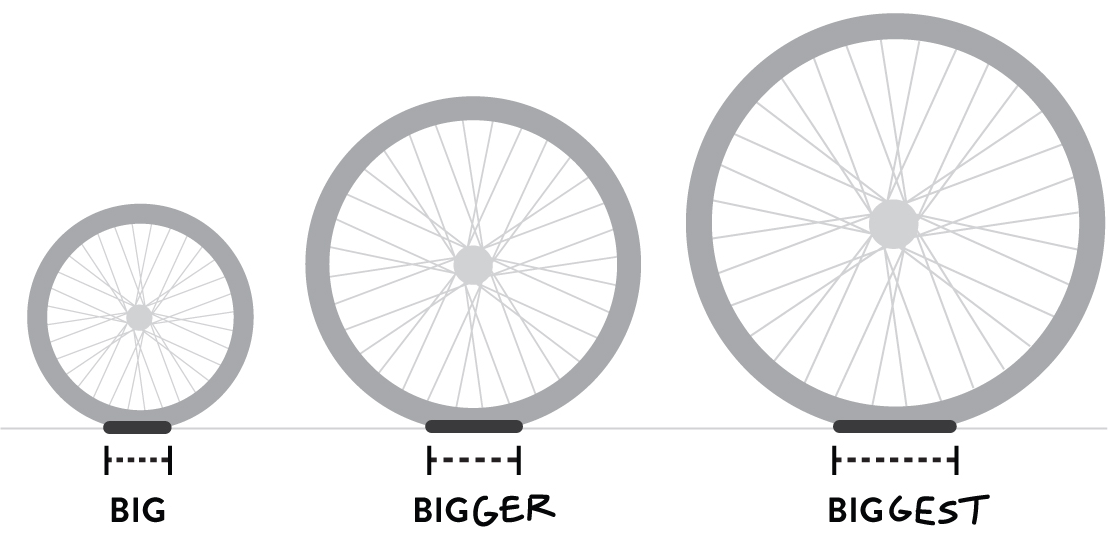When picking a mountain bike, the wheel size is crucial for handling and performance. Options like 26″, 27.5″, and 29″ affect how the bike navigates various terrains. Each size offers unique advantages, influencing the riding experience on trails and obstacles. Consider these differences carefully when selecting your mountain bike for optimal performance and enjoyment.
Mountain Bike Wheel Size
| 27.5-inch | 29-inch | |
| Maneuverability | Better | Less |
| Weight | Lighter | Heavier |
| Acceleration | Faster | Slower |
| Traction | Less | Better |
| Rollover Capability | Less | Better |
| Momentum | Slower | Faster |
| Rider Fit | Suits smaller riders | Suits taller riders |

Credit: m.youtube.com
Evolution Of Mountain Bike Wheel Sizes
The evolution of mountain bike wheel sizes has been a fascinating journey, shaping the way riders experience off-road terrain.
From 26-inch Legacy To Modern Trends
The traditional 26-inch wheels were once ubiquitous, offering maneuverability and agility on rough trails.
However, advancements in technology led to the introduction of larger wheel sizes for improved stability and traction.
Rise Of 29ers And 27.5-inch Wheels
29-inch wheels gained popularity for their ability to roll over obstacles with ease, enhancing momentum and comfort.
On the other hand, 27.5-inch wheels found a sweet spot between agility and rollover capability, appealing to a wide range of riders.
Impact On Performance
The choice of mountain bike wheel size can significantly impact performance. Larger wheels provide better rollover ability and stability, while smaller wheels offer improved agility and acceleration. Riders should consider their riding style and terrain to determine the most suitable wheel size for optimal performance.
Impact on Performance
Wheel Size and Bike Handling
When it comes to mountain bike wheel size, the impact on performance is significant. Understanding the relationship between wheel size and bike handling, speed, traction, and rolling efficiency is crucial for riders looking to optimize their riding experience.
Wheel Size and Bike Handling
The wheel size of a mountain bike plays a crucial role in its handling characteristics. Larger wheels, such as 29-inch, provide enhanced stability and smoother rolling over rough terrain. On the other hand, smaller wheels, like 27.5-inch, offer increased agility and maneuverability, making them ideal for technical trails and tight corners.
Speed, Traction, and Rolling Efficiency
The wheel size directly influences the speed, traction, and rolling efficiency of a mountain bike. Larger wheels have a larger contact patch with the ground, offering improved traction and better rollover capability, resulting in higher speeds and enhanced momentum retention. Conversely, smaller wheels accelerate more rapidly and are more responsive in tight turns, contributing to agile handling and quick acceleration.
In addition, the rolling efficiency of larger wheels is notable, as they tend to maintain momentum better over rough terrain, while smaller wheels are advantageous in technical and twisty trails, where rapid acceleration and nimble handling are essential.
In conclusion, understanding the impact of wheel size on performance is crucial for mountain bike enthusiasts seeking to optimize their riding experience. Whether prioritizing speed, agility, or traction, selecting the appropriate wheel size can significantly enhance a rider’s capabilities on the trail.
Factors To Consider When Choosing
When choosing a mountain bike wheel size, several factors should be considered to ensure the best fit for your riding needs. Understanding these factors can help you make an informed decision and enhance your riding experience. Here are the key considerations to keep in mind:
Rider Height And Comfort
Rider height plays a crucial role in determining the suitable wheel size for a mountain bike. Taller riders generally benefit from larger wheel diameters, such as 29 inches, as they provide better stability and smoother rolling over rough terrain. Conversely, shorter riders may find 27.5-inch or even 26-inch wheels more comfortable and manageable, especially when navigating tight corners and technical trails. Comfort is paramount, and the right wheel size can significantly impact how comfortable and confident you feel while riding.
Terrain And Riding Style
The terrain you predominantly ride on and your riding style are important factors to consider when choosing a mountain bike wheel size. For rough and varied terrain, larger wheels are generally preferred as they roll over obstacles more effectively and maintain momentum. On the other hand, if you primarily ride on tight, twisty trails or enjoy aggressive, technical riding, smaller wheels can offer increased agility and maneuverability. Understanding your preferred riding style and the typical terrain you encounter can guide you in selecting the most suitable wheel size for your needs.

Credit: www.bikeradar.com
Personalizing Your Ride
When it comes to mountain biking, the right wheel size can make a significant difference in your riding experience. Personalizing your ride by choosing the right wheel size can enhance your performance, comfort, and overall enjoyment on the trails. Let’s explore the options for customizing your mountain bike wheel size to suit your riding style and preferences.
Custom Builds And Upgrades
Customizing your mountain bike wheel size can be a game-changer in optimizing your bike for specific terrain and riding conditions. Whether you’re looking to upgrade your current setup or building a custom bike from scratch, selecting the ideal wheel size is crucial for achieving the desired performance.
Upgrading to a larger wheel size such as 29 inches can provide better traction and stability, especially on rough and technical trails. On the other hand, opting for 27.5-inch wheels may offer a more agile and maneuverable feel, ideal for tight corners and technical descents. Customizing your wheel size allows you to tailor your bike to your unique riding style and the terrain you frequent.
Future Of Wheel Size Innovations
As technology and innovation continue to drive the mountain biking industry forward, the future of wheel size holds promising advancements. Manufacturers are constantly exploring new materials and designs to improve the performance and durability of mountain bike wheels. Innovations in wheel size aim to strike a balance between speed, agility, and stability, offering riders the best of all worlds.
With the ongoing evolution of mountain bike wheel size, riders can anticipate exciting developments and options to further personalize their rides. Whether it’s the introduction of new wheel diameters or advancements in rim and tire technology, the future of wheel size in mountain biking is an exciting frontier to watch.

Credit: www.evo.com
Frequently Asked Questions
What Size Is A 26 Inch Bike Wheel?
A 26-inch bike wheel measures 26 inches in diameter. It is a standard size for mountain bikes and some hybrid bikes.
Why Have 29 Inch Wheels On A Mountain Bike?
29 inch wheels on a mountain bike offer better rollover ability and traction over obstacles. They provide a smoother ride and improved stability, making them ideal for rough terrain and downhill riding.
Are 26 Inch Wheels Good For Mountain Biking?
Yes, 26-inch wheels are suitable for mountain biking, offering agility and maneuverability on trails. They provide a good balance of speed and control for various riding styles.
Conclusion
Choosing the right mountain bike wheel size depends on your specific needs and preferences. It’s important to consider the terrain you’ll be riding on, as well as your own body size and riding style. Whether you opt for a 26-inch, 27.
5-inch, or 29-inch wheel, each has its own advantages and disadvantages. Ultimately, the best wheel size is the one that allows you to ride comfortably and confidently. So, take your time and do your research before making a decision. Happy riding!